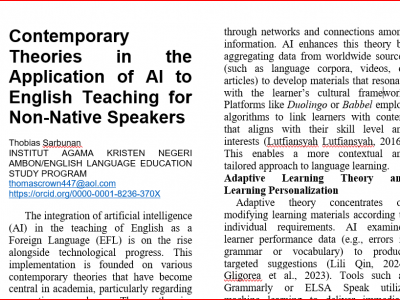Machine Learning
The integration of artificial intelligence (AI) in the teaching of English as a Foreign Language (EFL) is on the rise alongside technological progress. This implementation is founded on various contemporary theories that have become central in academia, particularly regarding non-native speakers. These theories encompass sociocultural approaches, connectivism, and adaptive learning, which work in conjunction with AI’s capacity to tailor learning experiences and enhance language engagement.
- Categories:
 30 Views
30 ViewsThe integration of artificial intelligence (AI) in the teaching of English as a Foreign Language (EFL) is on the rise alongside technological progress. This implementation is founded on various contemporary theories that have become central in academia, particularly regarding non-native speakers. These theories encompass sociocultural approaches, connectivism, and adaptive learning, which work in conjunction with AI’s capacity to tailor learning experiences and enhance language engagement.
- Categories:
 11 Views
11 Views
This is a voiceprint dataset with speaker's normal voice and special voice.
We recruited user test participants by snowballing. We directly invited 34 participants, all of them are family members, friends and classmates of the authors, ranging in age from 16 to 55, with similar technical backgrounds. Next, the involved participants further invited their relatives and friends to join, then 21 additional participants joined our user study. Finally, 56 people participated in our user study.
- Categories:
 3 Views
3 Views
This is a voiceprint dataset with speaker's normal voice and special voice.
We recruited user test participants by snowballing. We directly invited 34 participants, all of them are family members, friends and classmates of the authors, ranging in age from 16 to 55, with similar technical backgrounds. Next, the involved participants further invited their relatives and friends to join, then 21 additional participants joined our user study. Finally, 56 people participated in our user study.
- Categories:
 3 Views
3 ViewsThe Lemon Leaf Disease Dataset (LLDD) is a high-quality image dataset designed for training and evaluating machine learning models for lemon leaf disease classification. The dataset contains 9 classes of images of healthy and diseased lemon leaves, such as; Anthracnose. Bacterial Blight, Citrus Canker, Curl Virus, Deficiency Leaf, Dry Leaf, Healthy Leaf, Sooty Mould, Spider Mites, making it suitable for tasks such as plant disease instance segmentation, detection, image classification, and deep learning applications in agriculture.
- Categories:
 55 Views
55 Views
This dataset consists of meteorological and environmental data collected in Riyadh, Saudi Arabia, over multiple years. The variables include solar radiation, temperature (both maximum and minimum in Celsius and Fahrenheit), precipitation, vapor pressure, and snow water equivalent, among others. The data spans from 2010 to the present, providing insights into solar radiation patterns, daily temperature fluctuations, and weather-related factors that can impact solar power generation. Specifically, the dataset contains the following columns:
- Categories:
 43 Views
43 Views
SNMDat2.0 is a comprehensive multimodal dataset, expanded from the unimodal TwiBot-20, designed for Twitter social bot detection. Specifically, we add 274587 profile images and profile background images, 86498 tweet images and 49549 tweet videos based on the original 229580 twitter users, 227979 follow relationships and 33488192 tweet text.
- Categories:
 12 Views
12 Views
This dataset provides bibliometric information of academic publications related to learning analytics and decision sciences, sourced from Scopus. It includes metadata for a wide range of papers, including author details, titles, publication years, journal sources, and document types. Key columns in the dataset include author names, IDs, titles of publications, source titles (journals or conferences), document types, publication stage, and open access status.
- Categories:
 44 Views
44 Views
The rapid growth of spatiotemporal data makes trajectory modeling critical for extracting patterns from large-scale, dynamic mobility datasets. However, many existing methods face challenges with scalability and computational inefficiency. To address these challenges, we propose VecLSTM—a vectorized Long Short-Term Memory (LSTM) framework designed to improve both predictive accuracy and processing performance. VecLSTM introduces a novel dynamic vectorization layer that converts raw GPS trajectories into structured vector embeddings, enabling efficient storage, retrieval, and preprocessing.
- Categories:
 89 Views
89 Views
